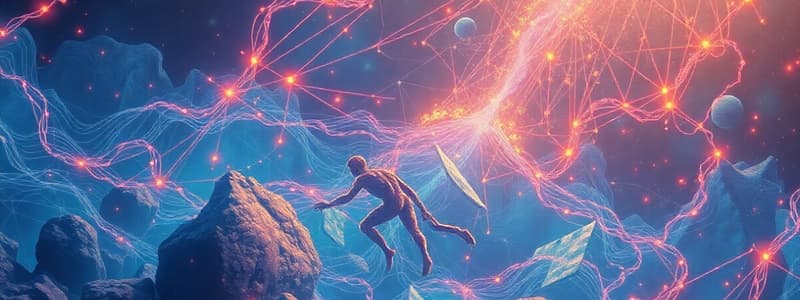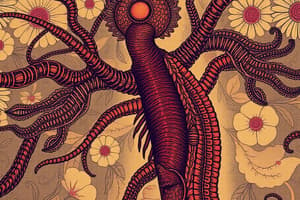Podcast
Questions and Answers
What is the main purpose of the excretory system?
What is the main purpose of the excretory system?
- To eliminate waste products and regulate water levels (correct)
- To produce hormones for growth
- To increase nutrient absorption in the intestines
- To filter toxins from the atmosphere
Which substance is primarily responsible for nitrogenous waste in mammals?
Which substance is primarily responsible for nitrogenous waste in mammals?
- Urea (correct)
- Ammonia
- Creatinine
- Uric acid
How does a hyperosmotic solution affect cell volume?
How does a hyperosmotic solution affect cell volume?
- It causes the cell to shrink due to water movement out (correct)
- It maintains a constant volume inside the cell
- It causes the cell to swell due to water influx
- It has no effect on cell volume
Which organ primarily filters out carbon dioxide from the blood?
Which organ primarily filters out carbon dioxide from the blood?
What role does the liver play in the excretion process?
What role does the liver play in the excretion process?
What is the main product of protein metabolism that is toxic and must be processed by the liver?
What is the main product of protein metabolism that is toxic and must be processed by the liver?
How does hydrostatic pressure affect fluids in the body?
How does hydrostatic pressure affect fluids in the body?
What term describes a solution with a lower concentration of solutes compared to another solution?
What term describes a solution with a lower concentration of solutes compared to another solution?
What is the primary role of the kidneys in the urinary system?
What is the primary role of the kidneys in the urinary system?
How does the hypothalamus contribute to maintaining fluid balance in the body?
How does the hypothalamus contribute to maintaining fluid balance in the body?
What condition leads to the release of Antidiuretic hormone (ADH) from the hypothalamus?
What condition leads to the release of Antidiuretic hormone (ADH) from the hypothalamus?
Which of the following correctly describes the main waste product excreted by the kidneys?
Which of the following correctly describes the main waste product excreted by the kidneys?
What role do ureters play in the urinary system?
What role do ureters play in the urinary system?
What substance is primarily filtered in the Bowman's capsule?
What substance is primarily filtered in the Bowman's capsule?
What happens when there is an excess of water in the body?
What happens when there is an excess of water in the body?
What would occur if the liver did not convert ammonia into urea?
What would occur if the liver did not convert ammonia into urea?
What is the primary role of vasodilation in temperature regulation?
What is the primary role of vasodilation in temperature regulation?
What happens when the body detects a decrease in temperature?
What happens when the body detects a decrease in temperature?
Which of the following describes a poikilotherm?
Which of the following describes a poikilotherm?
How do thermoreceptors contribute to temperature regulation?
How do thermoreceptors contribute to temperature regulation?
What is the function of osmosis in maintaining water balance?
What is the function of osmosis in maintaining water balance?
What condition is depicted by a solution that has a higher concentration of solutes compared to another solution?
What condition is depicted by a solution that has a higher concentration of solutes compared to another solution?
Which process is involved when blood returns to the body's core after cooling?
Which process is involved when blood returns to the body's core after cooling?
Which of the following accurately describes endotherms?
Which of the following accurately describes endotherms?
Flashcards
Hyperosmotic solution
Hyperosmotic solution
A solution with a higher solute concentration and lower water concentration than another solution.
Osmolarity
Osmolarity
Measure of total solute concentration in a solution, measured in osmoles/L.
Tonicity
Tonicity
Impact of a solution on cell volume, especially for non-penetrating solutes. Described as hypertonic, hypotonic, etc.
Nitrogenous waste (fish)
Nitrogenous waste (fish)
Signup and view all the flashcards
Nitrogenous waste (mammals)
Nitrogenous waste (mammals)
Signup and view all the flashcards
Nitrogenous waste (birds/reptiles/insects)
Nitrogenous waste (birds/reptiles/insects)
Signup and view all the flashcards
Excretion
Excretion
Signup and view all the flashcards
Liver's role in excretion
Liver's role in excretion
Signup and view all the flashcards
Liver's role in waste processing
Liver's role in waste processing
Signup and view all the flashcards
Urea's importance
Urea's importance
Signup and view all the flashcards
Kidney function
Kidney function
Signup and view all the flashcards
Urinary system's function
Urinary system's function
Signup and view all the flashcards
Nephron function
Nephron function
Signup and view all the flashcards
Antidiuretic hormone (ADH)
Antidiuretic hormone (ADH)
Signup and view all the flashcards
Urine formation process
Urine formation process
Signup and view all the flashcards
Urinary bladder function
Urinary bladder function
Signup and view all the flashcards
Hypothalamus Role in Temperature Regulation
Hypothalamus Role in Temperature Regulation
Signup and view all the flashcards
Vasodilation
Vasodilation
Signup and view all the flashcards
Vasoconstriction
Vasoconstriction
Signup and view all the flashcards
Shivering
Shivering
Signup and view all the flashcards
Homeotherm
Homeotherm
Signup and view all the flashcards
Poikilotherm
Poikilotherm
Signup and view all the flashcards
Endotherm
Endotherm
Signup and view all the flashcards
Ectotherm
Ectotherm
Signup and view all the flashcards
Study Notes
Homeostasis
- Maintaining a constant internal environment despite external changes
- Key homeostatic systems include blood pH, oxygen/carbon dioxide levels, body temperature, electrolytes, and blood sugar
- Homeostatic control systems have three main components
- Monitor system (receptors): sends signals through sensory pathways
- Coordinating center (brain): processes information and sends signals to motor pathways
- Regulator system (muscles, glands): carries out actions using hormones and adjustments
- These components work together via feedback loops to maintain stability
Negative Feedback
- Most common type of feedback
- Reverses or counteracts changes/opposes deviations
- Example: if body temperature rises above normal, sweating is triggered to lower temperature
Positive Feedback
- Less common than negative feedback
- Increases the change
- Example: oxytocin release during childbirth increases contractions until delivery
Thermoregulation
- Maintaining stable internal body temperature
- Hypothalamus acts as a thermostat, monitoring and adjusting body temperature
- Hypothalamus triggers responses if temperature is too high or low
- Activates effectors and hormones to communicate with organs and other systems
- Normal human temperature range: 36.2–37.2 degrees Celsius
Heat Stress
- Thermoreceptors in peripheral nervous system detect increased body temperature
- Signal sent to hypothalamus
- Hypothalamus coordinates a response to activate cooling mechanisms, like sweating
- Vasodilation (blood vessels dilate) to help release heat from blood
- Cooling internal systems as cooled blood returns to the core, cooling internal organs
Cold Stress
- Thermoreceptors in skin detect a drop in temperature
- Signal sent to hypothalamus
- Hypothalamus activates warming systems
- Vasoconstriction (blood vessels constrict) reduces blood flow to skin
- Shivering (muscle contractions) generates heat
- Goosebumps increase insulation
Water Balance
- Organisms maintain constant volume, solute content, and temperature
- Osmosis: water moves from lower solute to higher solute concentration
- Hypoosmotic: solution with lower solute concentration
- Hyperosmotic: solution with higher solute concentration
- Isosmotic: solution with same solute concentration as another
Nitrogenous Waste
- Fish and amphibians eliminate ammonia (NH3) requiring large amounts of water
- Mammals eliminate urea (NH2CONH2) requiring moderate amounts of water
- Birds and insects eliminate uric acid (c5h4n403) requiring very little water
Excretory System
- Removes waste products from the body
- Includes digestive, respiratory, skin, and urinary systems
- Kidneys filter water and urea
- Lungs filter carbon dioxide
- Skin excretes sweat containing urea
Liver
- Breaks down toxins like alcohol
- Converts toxic ammonia to less toxic urea
- Detoxifies the blood and removes harmful substances
Formation of Urine
- Steps in urine formation include filtration, reabsorption, and secretion
- Filtration: pushes water, urea, salts from glomerulus into bowman's capsule, large components like proteins do not pass
- Reabsorption: essential materials (glucose, amino acids, water) are reabsorbed by peritubular capillaries, maintains balance and conserves water and nutrients
- Secretion: nitrogenous waste, H+ and K+ are moved from blood to the nephron
Kidney Stones
- Hard deposits of minerals/salts that form in kidney
- Vary in size and shape causing pain when blocking urinary passages
- Common minerals forming kidney stones are calcium, oxalate, and uric acid
- Diagnosed through urinalysis (test of urine sample for high protein, blood, glucose, and pH)
Studying That Suits You
Use AI to generate personalized quizzes and flashcards to suit your learning preferences.



